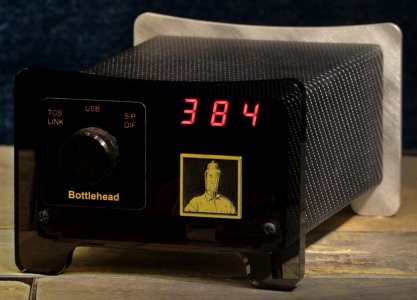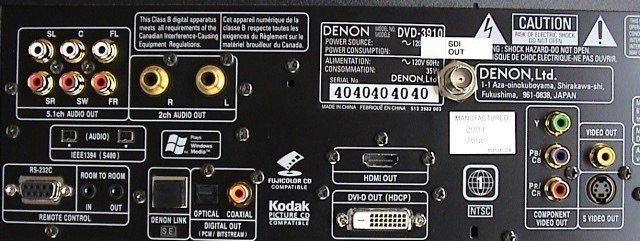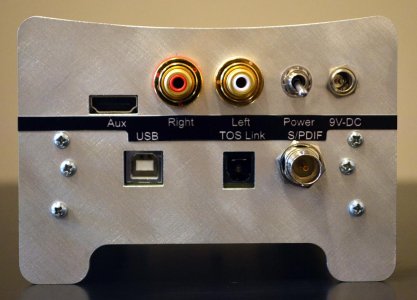You are using an out of date browser. It may not display this or other websites correctly.
You should upgrade or use an alternative browser.
You should upgrade or use an alternative browser.
Prototype images
- Thread starter Doc B
- Start date
Is the transport really of much importance to the final sonic result? Why not put a CD into a cheap DVD player and feed it to this DAC?
$1500 would stretch me (and no doubt others) a little, but that would be less of an issue if the source unit for the music is not of major importance. In other words, the DAC would be the real "front end", in a way. The price becomes trivial over long service - my current main CD player has been in constant use for 15 years, so the original purchase price has turned out to be modest in the long run.
DocB's comment reminds me that I actually have a Mac mini, too, sitting in a cupboard for the last year since I built a Hackintosh. If I could use it without a monitor, controlled from an ipod touch (no iPhone), it would be nice to bring it back into service. Is that possible?
$1500 would stretch me (and no doubt others) a little, but that would be less of an issue if the source unit for the music is not of major importance. In other words, the DAC would be the real "front end", in a way. The price becomes trivial over long service - my current main CD player has been in constant use for 15 years, so the original purchase price has turned out to be modest in the long run.
DocB's comment reminds me that I actually have a Mac mini, too, sitting in a cupboard for the last year since I built a Hackintosh. If I could use it without a monitor, controlled from an ipod touch (no iPhone), it would be nice to bring it back into service. Is that possible?
John Swenson
New member
PS2500 said:Is the transport really of much importance to the final sonic result? Why not put a CD into a cheap DVD player and feed it to this DAC?
$1500 would stretch me (and no doubt others) a little, but that would be less of an issue if the source unit for the music is not of major importance. In other words, the DAC would be the real "front end", in a way. The price becomes trivial over long service - my current main CD player has been in constant use for 15 years, so the original purchase price has turned out to be modest in the long run.
DocB's comment reminds me that I actually have a Mac mini, too, sitting in a cupboard for the last year since I built a Hackintosh. If I could use it without a monitor, controlled from an ipod touch (no iPhone), it would be nice to bring it back into service. Is that possible?
From my listening to it the S/PDIF inputs (coax or optical) are fairly immune to source differences. They are not completely immune, but pretty close. Everything I have tried has sounded very good, the best sounding ones are only slightly better sounding than the worst. So yes you can get very good results with pretty much anything you plug into it.
The USB input seems to have a bit more variability than the S/PDIF inputs. The BEST USB is a bit better than the best S/PDIF. But again it is not huge.
The BEST sound from this DAC seems to be with the USB input with a good USB cable (the Supra is superb) and a computer that has been tricked out for audio use, JUST audio use, scripts that turn off unnecessary stuff, audiophile player etc.
Note that NO configuration sounds bad, the lowest SQ out if this is still superb, it's just that if you really want to get into it you can wring a little bit more.
Going with the upcoming battery supply will probably be the biggest improvement.
John S.
We did a fair amount of comparison with TOSLINK from Mac mini vs TOSLINK from a Pioneer blu ray player. The differences were subtle and probably mostly due to using Amarra as the player on the Mac. I think whatever digital source you have right now will work nicely with the DAC, and that moving to a music server might be a future move made more for the convenience of having all your music in one place. All that said, a used Mac mini is relatively inexpensive.
John Swenson
New member
Speaking of S/PDIF coax input, you will have noticed from the pictures that the input is BNC not RCA. That means that you will need a cable with a BNC plug. My favorite to use for this is the Blue Jeans Cable digital audio cables. You can get them with RCA on one end and BNC on the other or BNC on both if you have a source that has that.
If you are one of the few that uses AES/EBU you can get transformers that convert to BNC, these will plug right in to the BNC jack.
John S.
If you are one of the few that uses AES/EBU you can get transformers that convert to BNC, these will plug right in to the BNC jack.
John S.
Johnnycopy
New member
Thanks for the responses on the input options.
Checked my denon 3910 and indeed it has rca and optical toslink outputs so i think they should work.
Any variability on various toslink cable types? Thanks for the blue jeans recommendation on rca to bnc. Is the bnc vs the toslink any different in sound quality?
Here is a picture of back of the denon just to ensure i have it right and can in fact use it as the transport.
Thanks again
Checked my denon 3910 and indeed it has rca and optical toslink outputs so i think they should work.
Any variability on various toslink cable types? Thanks for the blue jeans recommendation on rca to bnc. Is the bnc vs the toslink any different in sound quality?
Here is a picture of back of the denon just to ensure i have it right and can in fact use it as the transport.
Thanks again
Attachments
Since you won't be playing anything higher than a 96kHz file either coax or TOSLINK will work fine. It's difficult to say if one will be better than the other, as it seems dependent upon the player. My hunch is that a cheap TOSLINK cable might sound better on average than a really cheap coax cable. But if you spring for something like the blue jeans coax cable the difference might be very small.
I looked at the picture at the back of the amp, but didn't see any obvious connection for the power supply. Am I missing something? Is it proprietary, or something we can mate it to with a commercial umbilical cable connector if we build our own linear PS? Or, would that not be a not good idea and the connect ion should be re-engineered. (As i recall most plugs from wall warts are pretty puny).
It's a very standard connector. None of the linear supplies that we made sounded anywhere close to as good as the battery supply we will be releasing after the DACs start shipping.Frihed89 said:Is it proprietary, or something we can mate it to with a commercial umbilical cable connector if we build our own linear PS?
The demands on this connection are very low. You are certainly welcome to modify the DAC however you like, but you will forfeit the warranty in the process.Frihed89 said:Or, would that not be a not good idea and the connect ion should be re-engineered. (As i recall most plugs from wall warts are pretty puny).
-PB
mcandmar said:Upgraded sockets are a nice touch. Would it be possible to swap the power switch and input jack positions around? Just thinking it would be a little bit easier to find if its on the outer edge.
The power switch isn't meant to be turned off.
physicsmajor
New member
mcandmar said:Fair enough. I have an old DAC that subscribes to the same philosophy in that it doesn't even have a power switch, always puzzled me as to why it makes a difference.
Super high precision clocks drift with temperature. Not much, but when you need the precision you notice it. Computers etc. are designed binary so minor errors either don't matter or are checked and weeded out, but it matters for analog.
John Swenson
New member
physicsmajor said:Super high precision clocks drift with temperature. Not much, but when you need the precision you notice it. Computers etc. are designed binary so minor errors either don't matter or are checked and weeded out, but it matters for analog.
Temperature change on clocks is an important part, but there is another. DAC chips generate less jitter when they are warm, and I do mean warm as in higher temperature. All chips generate current pulses on their power and ground traces in the die and on the package bond wires. These variation in PS voltages create jitter due to threshold change in the chip. The amplitude of the current pulses a given piece of circuitry depends on how fast that circuit changes state. Total amount of charge transferred stays constant, so if the circuit is faster, the current is higher, which creates more jitter.
It turns out that as CMOS circuits heat up they get slower, thus generate less internal jitter. The hotter it gets the less jitter, up til the speed gets so slow the chip fails to operate. I have done several studies on this and found that hot chips DO sound better. This is part of the reason I design my DACs to be warm, they just plain sound better. Heat can also decrease chip life so there is a tradeoff here. Run a DAC warm but not HOT.
John S.
Similar threads
- Replies
- 0
- Views
- 136



